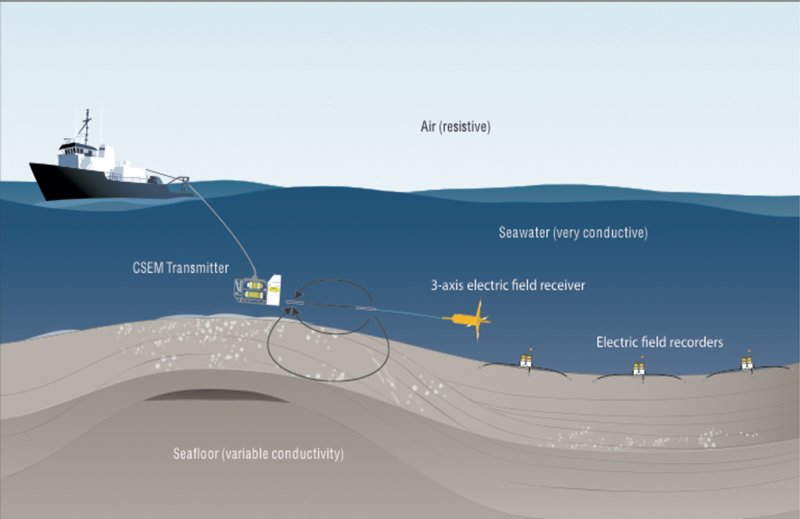BLUE MINING: Breakthrough solutions for sustainable deep-sea mining value chain
 Mineral extraction from the sea was investigated in the 1970s but abandoned due to changing market conditions. The main aim of the BLUE MINING project is to advance offshore mining technology by addressing all aspects from resource discovery to assessment and exploitation.
Mineral extraction from the sea was investigated in the 1970s but abandoned due to changing market conditions. The main aim of the BLUE MINING project is to advance offshore mining technology by addressing all aspects from resource discovery to assessment and exploitation.
The project involves 19 large industry and research organisations spread across Europe. The University of Southampton component of the project focuses on resource discovery and assessment using controlled source electromagnetic (CSEM) data. These data will be collected during a research cruise to the TAG area of the mid-Atlantic Ridge in 2016.
Information on the whole project can be found at www.bluemining.eu
Key Contact: Tim Minshull
3D Chirp – Decimetre resolution sub-bottom profiling
3D Chirp is a surface-towed sub-bottom profiling system capable of imaging the upper tens of metres of the sub-surface in three dimensions with decimetric horizontal and centimetric vertical resolution. This system has applications in shallow-water engineering, archaeology, military, and geological studies.
Key Contact: Jonathan Bull
Environmental Controls on the State of HV Cables under the Seafloor
Submarine HV cables are becoming increasingly important to modern power transmission strategies, as initiatives like offshore wind farms and the European supergrid are developed. Despite numerous studies into the behaviour of land-based cables, the thermal performance of cables under the sea floor has not been extensively investigated. This study aims to look at heat transfer in sediments through numerical modelling approaches. This project is in collaboration with the University of Southampton’s Tony Davies High Voltage Laboratories.
Key Contact: Tim Hughes (PhD Student), Tim Henstock
Hydrodynamic and Geotechnical Controls of Scour Around Offshore Monopiles
Scour, the removal of sediment from around the base of an object on the seabed, is a function of the interaction between hydrodynamics (tides and waves) and the geotechnical properties of the seabed. Left unchecked, scour can reduce the stability of offshore wind turbine foundations and the integrity of power cabling, and can also affect biological communities and heritage assets. This project uses a combination of field data and numerical models to look at the control of sediment heterogeneity on scour development around monopiles. This project is in collaboration with HR Wallingford.
Key Contact: Greg Melling (PhD Student), Justin Dix
Impact of seabed properties on the ampacity and reliability of cables
HV cables are frequently laid in trenches at the seabed and buried within local seabed sediments, with little thought about the thermal regime they will either enter or generate. This study aims to investigate the impact of varying rock and fluid properties on the thermal properties of marine sediment in order to quantify and fully understand the spatial and temporal variability of the thermal regime experienced by buried cables along cable routes on the UK shelf, it will achieve this through a combination of field studies and laboratory experiments. This project is in collaboration with the University of Southampton’s Tony Davies High Voltage Laboratories.
Key Contact: John Emeana (PhD Student), Justin Dix
Modern lacustrine, late-glacial and post-glacial environments and processes in Windermere, UK
An investigation into the active sedimentary processes, lake bed habitats and geomorphology of Windermere, in addition to interpreting Pre-Holocence and glacial features and the effects of anthropogenic activity. This study utilises multibeam bathymetry data, sediment samples and cores, and underwater video footage.
Key Contact: Helen Miller (PhD Student), Jonathan Bull
Overpressure Development in Deep Basins: Linking Measures and Models.
Pore pressure above the hydrostatic (overpressure) is common in deep basins. It plays an important role in pore fluid migration, represent a significant drilling hazard, and is one of the factors controlling slope stability and deformation in seismically active areas.
Key Contact: Tim Minshull
Storms and their seismic signals: Can seismometers be used to study oceans?
When ocean surface waves travelling in opposite directions interact, they generate a pressure signal through the whole water column, which excites seismic surface and body waves at the seabed. Seismic records therefore reflect ocean conditions, but the exact relation between what is recorded by a seismometer and what is happening in the ocean is still a mystery. This project aims to establish what the signals are telling us about the oceans, and how they can be used to monitor changes in the ocean and atmosphere.
Key Contacts: Jennifer Neale (PhD Student), Nicholas Harmon
Very-high-resolution seismic profiling has many uses in marine engineering, archaeology, homeland defence and geological applications. However, inferring sediment properties from seismic reflection data can be challenging, and is often heavily reliant on direct sediment sampling through coring, which can be time consuming and expensive. This project is the first application of acoustic impedance inversion to very-high-resolution seismic data. In doing so, extracting quantitative information regarding sediment properties.
Key Contact: Mark Vardy